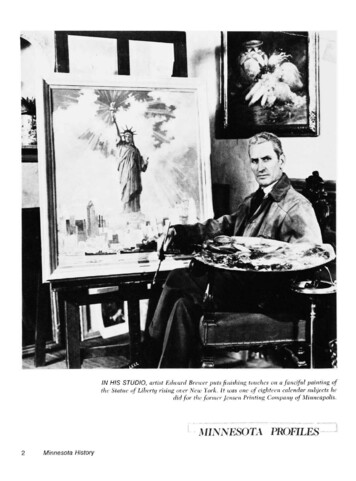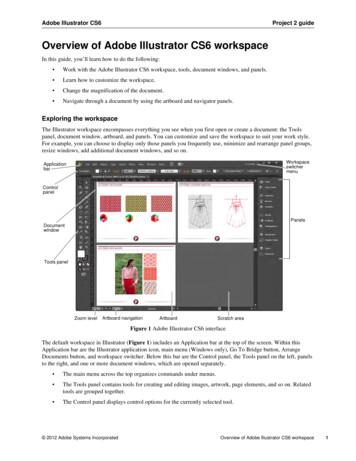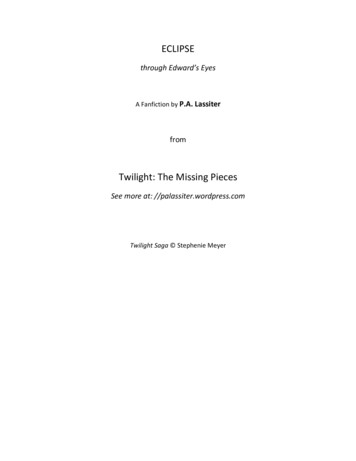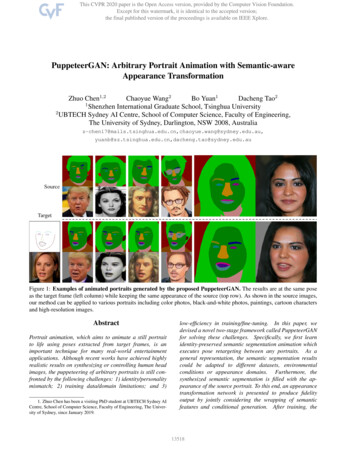
Transcription
IN HIS STUDIO, artist Edward Brewer puts finishing touches on a fancifid painting ofthe Statue of Liberty rising over New York. It was one of eighteen calendar subjects hedid for the former Jensen Printing Company of Minneapolis.MINNESOTAMinnesota HistoryPROFILES
Edward BrewerIllustrator andPortrait PainterPatricia Condon JohnstonE D W A R D B R E W E R of St. Paul was Minnesota's answer to famed illustrator Norman Rockwell. From 1911until 1926 Brewer created the enormously popular fullpage Cream of Wheat advertisements that appearedmonthly in dozens of national magazines. The folksy adsfor the Minneapolis company have become collector'sitems. And Brewer's reputation as an illustrator has beengiven a fresh coat of polish.The son of one of this country's finest portrait painters (and the father of a talented portraitist), EdwardBrewer was also a gifted muralist and portrait painter.His paintings of business, academic, and political leadersin Minnesota are included in numerous public and private collections. Several other examples of his work —portraits of governors and one of Abraham Lincoln — arein the Minnesota State Capitol in St. Paul. Ray Allen Billington, comp., Allan Nevin.i on History,174, 179 (New York, 197.5). The author wishes to thank Edward Brewer's children,Edward Lucien Brewer, Barbara Brewer Peet, and DavidBrewer, for their generous help in making this article a reality.Barbara Peet, especially, deserves special thanks for spendingseveral days with me, sifting through the many boxes of letters,other papers, and photographs (hereafter cited as Brewer Papers in the possession of Barbara Brewer Peet, St. Paul) thatwere salvaged when Brewer's studio burned shortly before hisdeath. She also supplied much personal family histor ' duringconversations with the author from November, 1978, throughJanuary, 1979. These will henceforth be cited Barbara BrewerPeet interviews.Patricia Condon Johnston is a free-lance writer living in Afton,Minnesota. Her magazine articles appear freijuenthj in American West, American History Illustrated, Early American Life,Americana, and a number of general-interest publications.Much of her writing reflects her special interest in the historyand people of her native Minnesota. This profile was writtenwith financial support from the National Endowment for theHumanities.0026-.5497/80/001.3-002 . 01.7.5/0When he died in 1971 at the age of eighty-eight, EdBrewer was something of a living legend. H e was Minnesota's dean of portrait painters. And his colorful past asa commercial artist was beginning to catch up with him. The Cream of Wheat ads, spanning the first quarterof this century, tell the storv of one of tire most successfulIWITHTHIS ARTICLEMinnesota Historylaunches a series of biographical .sketches of interesting Minnesota men and women from variousivalks of life whose achievementsare deemed.sufficient for them to merit profile treatment. Besides presenting the salient facts of the subject'slife, each profile ivill also attempt to characterizethe person and assess the significance of his or herwork.The editors proceed with this series on the basisof two as.sumptions: (1) that people like to readabout people and (2) that biography is one validway of .studying the past if one does not dependentirely on it. Allan Nevins warned that excessivedependence on biography "easily distorts history,"but he also ivrote: "The advantages of biography asa tool for examining the past are not to he unliistory.derrated. A good biography hunmnizesMost people are not much interested in past timesas a huge impersonal nmchine; they are interestedin how hunmn beings like themselves acted." Future profiles in this series will cover others in thearts and people in business, politics, and religion,welcomeamong nmny other fields. The editors.submissions of profiles on various men and womenin Minnesotahistory.— Ed.Spring 1980
advertising campaigns in the annals of American enterprise. The man behind the ads was Emery Mapes.The Cream of Wheat Company, long a Minneapolisinstitution, grew out of a small flour mill in Grand Forks,North Dakota, one that was floundering following thepanic of 1893. The cereal came into being much by accident; the account of its beginnings sounds something likea fairy tale.The Grand Forks milling business, reduced almost tobare bones during the economic crunch, was owned andoperated by a small group of men, including Mapes. Asecond hero in the drama was head miller Thomas Amidon, the man who provided the product to be advertised. For some time this thrifty miller had been takingthe middlings of the wheat berry home to his wife whomade a pleasing breakfast porridge from them. As thebusiness faced ruin, Amidon went to his partners withthe suggestion that perhaps the cereal could be marketed. What then happened was recorded by a companyhistorian: "The funds of the milling company were nowso low that Amidon had to cut the cardboard for thecartons by hand, label the packages himself and cratethem in wooden boxes made up from waste lumber.With no money to spend for package design, Mapes,who had once been a printer, found among his stock ofold printing plates a suitable illustration to brighten upthe package. It revealed the figure of a colored chef holding a saucepan over his shoulder and was the ancestor ofthe company's present-day widely known trademark. "''Ten cases of the cereal, called "Cream of Wheat, "were made up and shipped, without advance notice,with a regular car of flour to the mill's brokers in NewYork. It was an immediate success. The brokers telegraphed: "Forget the flour. Send us a car of Cream ofWheat."Flour production was halted, and the millturned its entire facilities over to making the cereal.Even so, by 1897 the demand for Cream of Wheat, fastbecoming an American staple, was straining the capacityof the small plant. In a move that has since been considered brilliant, the firm relocated in 1897 in Minneapolis,then the best source of raw materials and a good shippingpoint to other parts of the country.* (When the originalMinneapolis plant soon was outgrown, too, the companymoved to its own new building at First Avenue Northand Fifth Street. It remained there until 1928 when itmoved to its present site at 730 Stinson Boulevard. Itnow is part of the National Biscuit Company.)Mapes first began advertising in 1896 while the plantwas still in North Dakota. The earliest paintings used inthe ads bear no signatures. But after the turn of thecentury Mapes began reaching out, drawing on the talents of celebrated eastern illustrators such as JamesMontgomery Flagg, Phihp R. Goodwin, Jessie WillcoxSmith, and N. C. Wyeth. In 1906 Wyeth wrote to hisMinnesota Historymother: "Mr. Mapes of the Cream of Wheat Co. telegraphed for me to run up and see him at the WaldorfAstoria. H e is the owner of that famous cereal co., and isa man of immense wealth. I have just completed twopictures for him, 250 each, which h e is immenselypleased with." (These two paintings — " W h e r e theMail Goes Cream of Wheat Goes" and "The Bronco Buster " — currently hang in the Minneapolis Institute ofArts.) The imaginative ads, without type or text, appeared monthly — usually inside the front cover — insuch leading magazines as Collier's, The Modern Pri.scilla. Ladies' Home Journal, Leslie's, The Etude, Needlecraft, and Saturday Evening Post.''Ed Brewer's first Cream of Wheat ad, entitled "Dat'sMah Boy, " was published in 1911. "One day," Brewerwrote, "Mr. E m e r y Mapes.sent his car to mystudio, asking that I cafl. H e told me that h e had been inthe habit of going to New York every year to arrange forwork from many of the leading illustrators, but that hewould much rather patronize an artist who was righth e r e in the Twin Cities. " Thereafter, except for aperiod during 1912 and 1913 when his personal life oftenkept him from his work, Brewer produced paintings thatwere used almost monthly until the company changed itsadvertising format some fifteen years later.Like Norman Rockwell, Brewer painted to extraordinary advantage from his own surroundings, usuallydrawing his ideas from simple and famihar things andexperiences close to home. His zest for living enabledhim to find inspiration in the commonest of everydayoccurrences. "One morning," he wrote, "I entered thekitchen of our summer cottage with a fine bass for breakfast. My wife, in reaching for a package of breakfast food,discovered it to be empty. " The idea was quickly transferred to canvas and a p p e a r e d in t h e magazines as"Empty, By Heck!" H e frequently used his picturesque studio as a backdrop for his illustrations. Its wealthof antique furnishings appear as "props " for his figures.More often than not the bright-faced children in hispaintings were his own or those of his neighbors. For brief histories of the Cream of Wheat company, seeThe Story of "Cream of Wheat" (Minneapolis, Cream ofWheat Corporation, n.d.) and Hannah Campbell, Why DidThey Name It. .?, 3,5-37 (New York, 1964).''The Story of "Cream of Wheat," 2.' Campbell, Why Did They \kime It.?, 36.« Betsy James Wyeth, ed. The Wyeths. the Letters ofN. C.Wyeth, 1901-1945, 'l87 (Boston, 1971).'The author has a personal collection of more than 200different Cream of Wheat advertisements clipped from periodmagazines, some sixty of them by Edward Brewer. Edward V. Brewer, Composing an Advertising Illustration, n.p. (Minneapolis, 1918). This was a booklet published bythe Federal School of Commercial Designing in Minneapolis.A copy is in the Brewer Papers. Brewer, Compo.sing an Advertising Illustration, n.p.
Brewer himself once appeared in a Cream of Wheatad — called "A Proud Day for Rastus." Published in1914, the picture is a self-portrait of the artist sculpting aclay bust of the Black chef It was true to life; Brewer didmake such a bust. Earher advertisements, both Brewer'sand those of other artists, had always shown the cheffull-face. Now, with his three-dimensional model. Brewer began to paint him from a variety of angles. This adwas also the first to dub the figure (who had been nameless) "Rastus."The earliest Brewer ads, though highly effective,were usually fairly sparse, economical compositions andoften concentrated on a single figure. As the 1920s approached, however, his work improved noticeably. Hisbackgrounds became more elaborate and complete. Andtoward the end of the series, the faces of his figures,which had started as characterizations, became portraits.There is no mistaking his son David in many of theselater advertisements. And his daughter Barbara is themake-believe queen in a 1923 Christmas piece, "To theQueen's Taste. "Possibly the finest picture Brewer painted for Creamof Wheat ads was one of the very last. A poignant portrayal of David posing as a newsboy beside a monumentto Abraham Lincoln (see cover), the painting was titled"Mighty Oaks from Tiny Acorns Grow " and became thebest known of his advertisements. It was also the specialfavorite of his wife Ida, and during the last years of herfife — she died of cancer on October 6, 1961 — Brewertried repeatedly to buy back or borrow the original painting from Cream of Wheat. After much deliberation onthe part of company officials, the picture was finally returned. But, Ed would tell in later years, Ida had notlived to see it come home. It is the only original Creamof Wheat painting by Brewer that remains in the family.Other original pieces are housed in the corporate officesof the Nabisco company in East Hanover, New Jersey,which purchased Cream of Wheat in the early 1960s.PHOTOGRAPHSoften helped Brewer get the effects hewanted for the simple, folksy themes he frequentlyusedAbove, hisin his Cream of Wheat ad illustrations.daughterBarbara(second from left) andotheryoungsters strike a snowball-throwingpose for Brewer.The resulting painting he produced is shown below. Entitled "Well Fortified," it had a 1923 copyright and appeared in magazines in January, 1924.E D W A R D V I N C E N T BREWER was born in St. Paulon April 12, 1883, the second of six sons of NicholasRichard and Rose Koempel Brewer. There was everyreason to believe even then that h e would become anartist, as would two of his brothers. H e grew up in anatmosphere dedicated to the pursuit of painting. Hisfather before him was forging the trail Ed would foUow.The father's story, and that of Ed's childhood, is told inNicholas Brewer's autobiography, which the latter published privately in 1938 when h e was eighty-one. Nicholas Brewer had been born in 1857 in a log cabin1" Information in this paragraph is based on conversationsthe author had with Brewer in 1967."Nicholas R. Brewer, Trails of a Paintbrush (Boston,1938); Barbara Brewer Peet interviews."WELL rOHTIFIEDSpring 1980
NICHOLAS R. BREWER (secondfrom left, front row), afamous artist in his own right, and his wife Rose posedwith their .six sons for this family portrait. The four in theback row (from left) are Edward, Reuben, William Wallace, and Adrian. Flanking the parents are FrancisReubenAngela (left) and Clarence, a tivin of Adrian's.and Adrian were also painters, and Clarence was adeptat producing fratnes for "the Brewery."on the north branch of the Root River near High Forest,O l m s t e d C o u n t y , in s o u t h e r n M i n n e s o t a . H e hadsketched from early childhood, and his mother had encouraged his interest in art. But there had been nomoney to send him to art school. Instead, as Nicholastold it, when he was eighteen his father gave him awagon filled with forty bushels of wheat, a grubstake ofsorts, which the youth drove to Rochester and sold for 34.00. Then he boarded a train for St. Paul. There hewas sure he could learn more about drawing and painting. However, St. Paul in 1875 possessed neither art norartists, and the only teacher he could find was a Germannamed Henry J. Koempel who painted copies of picturesand d e c o r a t e d c h u r c h e s . K o e m p e l a g r e e d to giveNicholas art lessons at fifty cents a session and hired himas an apprentice when he could. Mostly, though, youngBrewer d e p e n d e d on painting houses and fences to payhis rent. Then in May, 1879, in a Roman Catholic ceremony at Assumption Church in St. Paul, Nicholas Brewer married Koempel's daughter, Rose.' Nicholas was destined to become a fine painter. Hislandscapes and portraits were later exhibited, in cooperation with n u m e r o u s museums and art leagues.Minnesota Historythroughout the country. Among nationally prominentfigures w h o p o s e d for his p o r t r a i t s w e r e I g n a c ePaderewski, Ulysses S. Grant, Henry Ward Beecher,and President Franklin D. Roosevelt. But success didnot come easily.As soon as Nicholas was able, he and Rose and the firstof their sons moved to New York so h e could meet, andstudy with, respected artists. Rose, however, could notadjust to the New York scene. She belonged to a large,close-knit family, and her health deteriorated noticeablyas the time lengthened that she was separated from herkin. For a time at least. Brewer had to resign himself toreturning to St. Paul. Although he preferred landscapes,h e was becoming adept at portraits, which sold moreeasily, and was able to secure commissions in the TwinCities until he felt the family was ready to try going backto New York. But the second move proved no moresuccessful than the first, for the same reason, and onceagain the Brewers returned to St. Paul. Curiously, theBrewer family, which was increasing in size, would moveto New York and back a total of five times. In later years,Nicholas worked out a compromise: he maintained astudio in New York and his family in St. Paul. *D u r i n g one of t h e interim periods in St. Paul,Nicholas estabfished an art school (the first of its kind inMinnesota) in the Seven Corners area. H e furnished itmeticulously, purchasing numerous antique casts of theVenus de Milo, Michelangelo's David, heads of Vitellius,Germanicus, St. Francis, and others, as well as anonymous torsos, feet, and hands. H e p u t together, too, ahandsome collection of brass pots, kettles, jugs, and thelike to tempt students to do still fifes. H e also saw to itthat there was a model throne for the figure model in thelife class as well as plenty of draperies and costumes. Thestudio, he thought, compared quite favorably with anything h e had seen in New York.Even so, few of his students remained with him forlong. Nicholas was a demanding teacher who insistedespecially that students not copy pictures — as was acommon practice in art classes in local academies andprivate schools — but instead create their own. H e hadbeen taught to do this in New York, and h e would notlower his standards. Consecjuently, the fledgling studiodid not provide much income. Then, shortly after theschool opened, came the panic of 1893, the worst financial disaster tlie country had seen. Banks and businessesclosed one after anotlier. And paintings and art schoolsbecame superfluous commodities.'*T H E BREWERS moved to a small farm at Stacy, Min12 Brewer,' BrcwiM-, Brewer,' " Brewer,Trails of a Paintbrush,Trails of a Paintbrush,Trails of a Paintbrush,Trails of a Paintbrush,23, 25, 31-32, .53.55-57, 64-68.82, 101-103, 202.104-106.
nesota, where Nicholas' parents were fiving. There, between chores, Nicholas found time to paint landscapes.Occasionally one could be traded for a horse or a pig.And the experience was good for the boys. Edward inparticular became completely engrossed in the countryatmosphere. "It was useless," Nicholas said, "to sendhim on an errand; he was sure to forget it and wander offchasing butterflies, poking after frogs, or robbing birds'nests. " But he also mentioned Ed's "predilection fordrawing and sketching" and added: " H e had a manner ofscrawling his n a m e at the top of his paper, saying,'Well, I have to make my n a m e first!" and it wasNicholas who saw to it that Ed later attended the ArtStudents' League in New York.' Many years l a t e r — at the tail end of World War I, bywhich time h e had already achieved national recognitionfor his Cream of Wheat ads — Ed Brewer wrote theshort, largely biographical, booklet (see footnote 8) forstudents of the Federal School of Commercial Designingin Minneapolis (now Art Instruction, Inc.). In it he explained his decision to become a professional artist:From the age of sixteen to twenty-one I worked inoffices in St. Paul at general clerical work onmeagre salaries, but the joy of this kind of workdid not present itself. Therefore when my fathersuggested that I go to New York with him andattend the Art Students' League 1 took on a newlease of life. At the League I studied antiquedrawing under Kenyon Cox for a month and lifedrawing for a n o t h e r m o n t h u n d e r F r a n k VDuMond, when I was admitted to the illustrationclass under Walter Appleton Clark. At the end ofanother month vacation arrived and having taken"first" in the concour[s] for that month, we decided that I had some talent, at least.1 returned home and spent the summer painting fish, birds, and wild life. I also made a watercolor pastel drawing which it s e e m e d to meshould b e on the March cover of the Ladies'H o m e Journal. Of course I expected they wouldcome to meet my painting at the station, and as Ilook back now at the strange fate of that cover iti Brewer, Trails of a Paintbrush, 114-115, 173 (quotes).1''Brewer, Composing an Advertising Illustration, n.p.This is also the source for the next paragraph.' Edward Lucien Brewer to Patricia Johnston, January 22,1979, letter in latter's possession. Barbara Brewer Peet interviews. Copies of Brewer's advertisements and illustrations, as well as catalog and magazinecovers, are in the Brewer Papers.2"Patricia Johnston telephone interview with Edward Lucien Brewer, Lakeside, California, January 26, 1979. An undated, unidentified news clipping describing the CommercialClub murals is in the Brewer Papers.amuses me. The letter for which I ran two milesevery day for a week actually contained a checkfor forty dollars, although the picture finally appeared over another artist's name. However, thiswas forty dollars' worth of encouragement. 'Brewer was back in New York the next fall, knockingon doors, looking for commercial assignments. Wildlifewas still his favorite subject matter, and the prospects forselling it looked good. A classmate of his at the Art Stud e n t s ' League — Lynn Bogue H u n t — was doingnumerous ads and posters for grm and ammunition manufacturers like Remington, W i n c h e s t e r , and U n i t e dMetallic Cartridge. But finding work in that fafl of 1902was not as easy as Ed had expected. Reluctantly, he tookanother clerical job, this time at the New York EdisonCompany, but he spent most of his spare time "makinghunting pictures and speculative covers. " H e called onlikely clients during his lunch hours. Finally, in oneweek he sold two paintings for 90. Elated, he quit hisjob and opened a studio.In 1905 Ed returned to St. Paul to marry MaymeSmith of that city. His parents had quit the farm andwere back in St. Paul. Family members have suggestedthat his mother. Rose, had had a hand in airranging thisfirst marriage. Mayme went to New York with Ed, and in1907 their son, Edward Lucien, was born.'*Brewer's career was now on the upswing. H e turnedout numerous sporting magazine advertisements and illustrations, including work for firearms manufacturers.H e did both catalog covers and inside illustrations forAbercrombie and Fitch and the Browning BrothersSporting Goods Company. H e also produced magazinecovers for Life, a periodical that predated the modernLife, and Field and Stream. Before long h e had workedhimself up to art editor of Field and Stream. (YoungFrancis Lee Jaques, who later b e c a m e Minnesota'smost-respected wildfife artist, was also testing the NewYork waters. The two became*acquainted when Jaquessubmitted artwork to Field and Stream and remainedlifelong friends.)' The New York years came to an abrupt end, however, when Mayme Brewer, who had been ailing, wasdiagnosed as having tuberculosis. Ed and his family, following the familiar pattern set by his parents, setdedagain in St. Paul. For a while they stayed with theNicholas Brewers; the father's fortunes were just then athigh tide, and his magnificent Casa del Rio on Mississippi River Boulevard was near completion and ready foroccupancy. After that Ed's family took an apartment onOak Grove in Minneapolis where he set up a studio. TheCream of Wheat account became a reality now, andthere were other commissions as well. The MinneapolisCommercial Club, for example, ordered six wildlifemurals, each 5-by-15 feet, to be hung in its headquartersat the Radisson Hotel. ' Spring 19807
ALL SET for a .spin iti their fancy motorcycle and sidecarare Ed Brewer, his first wife (the former Mayme Smith),and their son, Edward Lucien, who was born in 1907 andnoiv lives in Lakeside,California.But Mayme was steadily declining, and late in 1911Ed moved his small family to El Paso, hoping the sunnywestern Texas climate would hasten his wife's recovery.The winter months were certainly more tolerable there,b u t even so Mayme succumbed on May 19, 1912. With aheavy heart and a small son, Ed returned to St. Paul.Although h e dreamed throughout his life of going back toNew York, he never worked there again. 'ON FEBRUARY 24, 1914, Ed Brewer took a secondbride, Ida Kueffner, the daughter of a St. Paul lawyer.She shared Ed's interest in art. Ida was a graduate of theChicago Institute of Art and had taught children's classesat the St. Paul Gallery and School of Art. She had alsow o r k e d for a t i m e p a i n t i n g s t a i n e d glass for t h ePittsburgh Plate Glass Company in St. Paul and hadrecently opened her own studio where she could complete private commissions. A promising artist herself,Ida nonetheless gave up her career when she marriedBrewer. The couple had two children, Barbara and David. Onoccasion Ida found excuses to go back to her drawingboard. She did produce several illustrations to accompany a serialized story in Everybody's Health, a Minnesota publication, in 1933 (her husband's touch is evident in the drawings, however). '' But mostly, daughterBarbara recalls. Brewer gave his wife little encouragement to paint. She contributed substantially to his work,though, by doing research for him, particularly when hewas working on historical murals.8MinnesotaHistoryThe Cream of Wheat ads provided a major portion ofthe Brewers' income up to the mid-1920s. After thatthere were both good times and lean times — the life of afree-lance artist always being somewhat chancy. Ed prepared advertisements for an endless variety of products,including Halligan's Chocolates, Toro lawn mowers, andthe "Gotzian Hiawatha Shoe for Children." Both Brewers collaborated on an illustrated cookbook for "Aristos— the Never-Fail Flour. " Ida developed and tested therecipes. In the early 1930s, Brewer did some largeposter paintings for the Northern Pacific Railroad. Onesummer Ed asked for railway tickets and lodging in heuof pay, and the whole family went west for severalweeks, staying at the Paradise Lodge at Mount Rainier, aNorthern Pacific facility. '*In 1933 Ed received a commission to paint a largemural picturing the early days of the West for theS p o k a n e and E a s t e r n T r u s t C o m p a n y b u i l d i n g inSpokane, Washington. Bankers there were impressedwith pictures he carried showing several of the imposingsixteen-foot murals he had recently completed for theBatavian National Bank in La Crosse, depicting the birthand growth of that city. This Wisconsin series beginswith a panel showing Indians playing lacrosse on the siteof the present city and ends with a modern bird's-eye21 Edward Lucien Brewer telephone interview.22Barbara Brewer Peet interviews.23A copy of this publication is in the Brewer Papers.2''Barbara Brewer Peet interviews. Copies of the advertisements mentioned and others are in the Brewer Papers.BREWER is pictured witli his second wife (the formerIda Kueffner) whom he married in 1914. They had twochildren, Barbara and David. Ida was an artist herselfbut gave up her art career after their marriage.' ''''f
THIS HUGE MURAL, one of a series Brewer did for aLa Crosse, Wisconsin, bank depicting that city's birthforegroundand growth, .shows Indian spectators inwatching a spirited game of lacrosse below.view of La Crosse from its sentinel mountain, "OldGranddad. "25Brewer completed most of the mural work in his ownstudio. H e had rigged up a roller arrangement which helda canvas up to eighteen feet high, enabling him to paintalways at eye level. W h e n the canvases were finished,they were delivered to their destinations and hung. Themurals usually had a historical theme, but Brewer alsodid an imaginative series of fairy-tale murals for theLeamington Hotel in Minneapolis. (In general. Brewer'smurals are reminiscent of those of N. C. Wyeth, considered by many to have been the best of American iflustrators, whom Brewer consciously sought to emulate.)2 Brewer also did diorama backdrops at t h e BellMuseum of Natural History at the University of Minnesota. When the animal habitat groups were movedfrom the old zoology building to the new museum in Undated news clipping from the Spokane Daily Chronicle in the Brewer Papers; La Crosse Tribune, February 8, 1929;Brewer, Trails of a Paintbrush, 174.2*Barbara Brewer Peet interviews.2''Patricia Johnston telephone interview with Walter J.Breckenridge, former director of the Bell Museum, January 3,1978.28Patricia Johnston telephone interviews with Gordon Jensen of the Jensen Printing Company and his mother, Mrs.Charles H. Jensen of Minneapolis, in January, 1979.1940, B r e w e r was c o m m i s s i o n e d to e x t e n d t h ebackgrounds for several of the exhibits which had beenin smaller cases. Matching his colors precisely to those ofthe old backdrops, he enlarged the paintings for severalof the groups still on display, including the Heron Lakebird group originally painted by Louis Agassiz Fuertes.Brewer also created complete backgrounds for the neweagle and raccoon groups. It was the kind of work hisfriend, Lee Jaques, was doing at the American Museumof Natural History in New York. In later years, Jaquesalso did backdrops at the Bell Museum. The author oncesaw a painting, now in private hands, that was a sketchfor one of the diorama backgrounds at the Bell. It wassigned Jaques/Brewer. Jaques had started it; Brewerhad finished it.For some twent ' years starting in the early 1940s,Brewer made annual calendar paintings, scenes of historic Minnesota, for the Jensen Printing Company inMinneapolis. His popular version of the Hastings SpiralBridge, a perennial favorite and one that has been reprinted numerous times, was one of these. H e alsoproduced calendar pictures of such subjects as the Fallsof St. Anthony, the Sibley House in Mendota, Red Riveroxcarts, and the Minnesota State Fair. The calendars,printed in quantities of about 2,000 each for distributionto Jensen's friends and customers, have become collector's items. Most of the original Brewer paintings areowned by Mrs. Charles H. (Jean) Jensen, the widow ofthe head of the firm. *REAL BEARS? No, stuffed. Brewer posed with themwhile painting backgrounds for animal habitat groups atthe Bell Museum of Natural History on the Minneapoliscampus of the University of Minnesota. He extendedbackgrounds of exhibits when they were moved in 1940.
/\ GAME of "some like it hot, some like it cold" betweencontrasting partners was featured in a Cream of Wheatad for magazines in February, 1924."FROM SUNRISE to Tivilight," a 1924 painting, was setin Brewer's favorite lower room. The metal arm in thefireplace was from Lincoln's funeral car.Reprints of Cream of Wheat cereal advertisements by permission of Nabisco, Inc."KEEPING WATCH," an appealing version of a uni
swer to famed illustrator Norman Rockwell. From 1911 until 1926 Brewer created the enormously popular full-page Cream of Wheat advertisements that appeared monthly in dozens of national magazines. The folksy ads for the Minneapolis company have becom e collector's items. And Brewer's reputation as an










